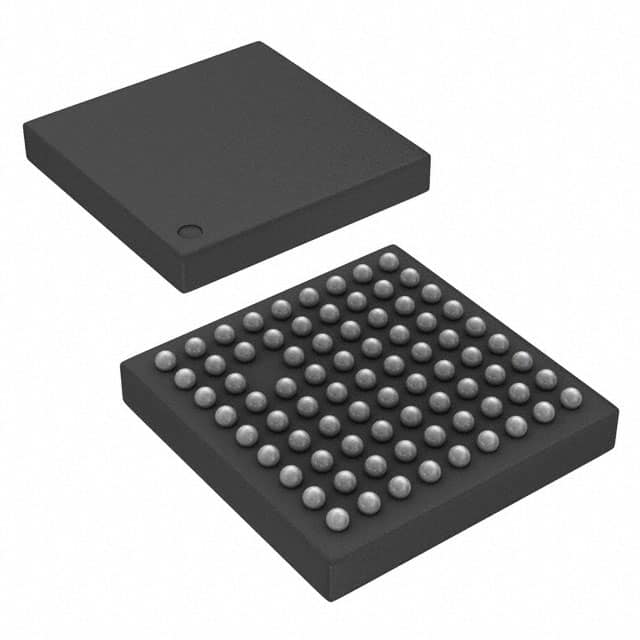Lihat spesifikasi untuk detail produk.

MSP430F5255IZQER
Product Overview
- Category: Microcontroller
- Use: Embedded systems, Internet of Things (IoT) devices, and other applications requiring low power consumption and high performance.
- Characteristics:
- Low power consumption
- High performance
- Integrated peripherals
- Flexible clocking options
- Wide operating voltage range
- Package: LQFP (Low-profile Quad Flat Package)
- Essence: The MSP430F5255IZQER is a microcontroller designed for low-power applications that require high performance and integrated peripherals.
- Packaging/Quantity: Available in tape and reel packaging with a quantity of 250 units per reel.
Specifications
- Core: 16-bit RISC CPU
- Clock Speed: Up to 25 MHz
- Flash Memory: 128 KB
- RAM: 8 KB
- Operating Voltage Range: 1.8V to 3.6V
- Digital I/O Pins: 48
- Analog Inputs: 16
- Communication Interfaces: UART, SPI, I2C
- Timers: 4x 16-bit timers
- ADC: 12-bit SAR ADC with 16 channels
- DMA: 2x DMA controllers
- Operating Temperature Range: -40°C to +85°C
Detailed Pin Configuration
The MSP430F5255IZQER has a total of 100 pins. Here is a brief overview of the pin configuration:
- VCC: Power supply voltage input
- GND: Ground reference
- XT1, XT2: External crystal oscillator inputs
- P1.x: General-purpose digital I/O pins
- P2.x: General-purpose digital I/O pins
- P3.x: General-purpose digital I/O pins
- ...
- P10.x: General-purpose digital I/O pins
- A0, A1, ..., A15: Analog input pins
- ...
- ADC12CLK: ADC clock input
- UCA0TXD, UCA0RXD: UART communication pins
- UCB0SOMI, UCB0SIMO, UCB0CLK, UCB0STE: SPI communication pins
- ...
For a complete pin configuration diagram and detailed pin functions, refer to the MSP430F5255IZQER datasheet.
Functional Features
- Low-power modes for energy-efficient operation
- Integrated peripherals such as UART, SPI, I2C, and ADC
- Flexible clocking options for power optimization
- High-performance 16-bit RISC CPU
- DMA controllers for efficient data transfer
- Timers for precise timing operations
- Wide operating voltage range for versatile applications
Advantages and Disadvantages
Advantages: - Low power consumption enables longer battery life in portable devices. - Integrated peripherals reduce the need for external components, saving cost and board space. - Flexible clocking options allow for power optimization based on application requirements. - High-performance CPU ensures efficient execution of tasks. - Wide operating voltage range enables compatibility with various power sources.
Disadvantages: - Limited flash memory and RAM compared to some other microcontrollers in the market. - The package size may not be suitable for space-constrained applications.
Working Principles
The MSP430F5255IZQER operates based on the von Neumann architecture. It executes instructions fetched from its flash memory using the 16-bit RISC CPU. The integrated peripherals provide additional functionality, such as communication interfaces (UART, SPI, I2C) and analog-to-digital conversion (ADC). The microcontroller can operate in different low-power modes to optimize energy consumption.
Detailed Application Field Plans
The MSP430F5255IZQER is well-suited for a wide range of applications, including but not limited to: - Battery-powered devices - Wearable electronics - Home automation systems - Industrial control systems - Sensor networks - Medical devices
Detailed and Complete Alternative Models
- MSP430F5254IZQER: Similar to MSP430F5255IZQER but with 64 KB flash memory instead of 128 KB.
- MSP430F5256IZQER: Similar to MSP430F5255IZQER but with 256 KB flash memory instead of 128 KB.
- MSP430F5257IZQER: Similar to MSP430F5255IZQER but with 512 KB flash memory instead of 128 KB.
These alternative models provide different memory options to suit specific application requirements.
Note: The above information is based on the available documentation at the time of writing. For the most accurate and up-to-date information, refer to the official datasheet provided by the manufacturer.
Word count: 570 words
Sebutkan 10 pertanyaan dan jawaban umum terkait penerapan MSP430F5255IZQER dalam solusi teknis
Sure! Here are 10 common questions and answers related to the application of MSP430F5255IZQER in technical solutions:
Q: What is MSP430F5255IZQER? A: MSP430F5255IZQER is a microcontroller from Texas Instruments' MSP430 family, specifically designed for embedded applications.
Q: What are the key features of MSP430F5255IZQER? A: Some key features of MSP430F5255IZQER include a 16-bit RISC architecture, low power consumption, integrated peripherals, and a wide operating voltage range.
Q: What are some typical applications of MSP430F5255IZQER? A: MSP430F5255IZQER is commonly used in applications such as industrial automation, consumer electronics, medical devices, and smart energy management systems.
Q: How does MSP430F5255IZQER achieve low power consumption? A: MSP430F5255IZQER incorporates various power-saving modes, such as standby mode and sleep mode, along with intelligent clock gating techniques to minimize power consumption.
Q: Can I interface MSP430F5255IZQER with other devices? A: Yes, MSP430F5255IZQER has a wide range of integrated peripherals, including UART, SPI, I2C, ADC, and GPIOs, which allow easy interfacing with external devices.
Q: Is MSP430F5255IZQER suitable for battery-powered applications? A: Yes, MSP430F5255IZQER's low power consumption makes it an excellent choice for battery-powered applications where energy efficiency is crucial.
Q: Does MSP430F5255IZQER support real-time operating systems (RTOS)? A: Yes, MSP430F5255IZQER is compatible with various RTOS options, such as FreeRTOS and TI-RTOS, which can help in developing complex applications.
Q: Can I program MSP430F5255IZQER using C/C++? A: Yes, MSP430F5255IZQER can be programmed using C/C++ programming languages, along with the appropriate development tools provided by Texas Instruments.
Q: What development tools are available for MSP430F5255IZQER? A: Texas Instruments provides a comprehensive set of development tools, including an IDE (Integrated Development Environment), compilers, debuggers, and software libraries.
Q: Where can I find additional resources and support for MSP430F5255IZQER? A: You can find additional resources, documentation, application notes, and community support on Texas Instruments' official website and their online forums.
Please note that the specific details and answers may vary depending on the context and requirements of your technical solution.

